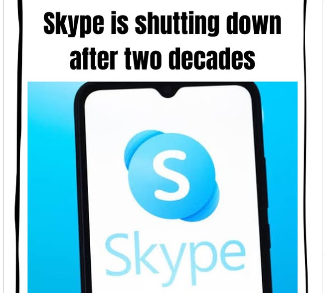Skype was the industry standard for online communication for almost 20 years, bringing friends, family, and companies together all over the world. However, Microsoft has now formally acknowledged that it will shut down in May, bringing an end to a once-revolutionary platform.
The decision to discontinue Skype coincides with Microsoft’s long-awaited decision to concentrate entirely on Teams. Skype became less relevant as competition from Zoom, WhatsApp, and Google Meet increased. However, did Microsoft purposefully phase out Skype in favor of its more recent product, or is this simply an evolution of communication tools?
Key Milestones in Skype’s Journey
| Year | Event |
|---|---|
| 2003 | Skype launched in Estonia, offering free voice and video calls |
| 2005 | eBay acquired Skype for $2.6 billion but later sold it |
| 2011 | Microsoft bought Skype for $8.5 billion, integrating it into its ecosystem |
| 2017 | Microsoft launched Teams, shifting focus away from Skype |
| 2021 | Windows 11 replaced Skype with Teams as the default communication tool |
| 2023 | Microsoft discontinued Skype phone numbers and credits |
| 2025 | Microsoft announces Skype’s shutdown in May, directing users to Teams |
📌 Reference: Microsoft Official Announcement
The Fading of Microsoft’s Billion-Dollar Investment
- Microsoft is finally discontinuing Skype. The Reason It’s Occurring Now
The industry leader in online communication, Skype, is finally being phased out. With Microsoft switching to Teams and newer, more flexible platforms becoming more competitive, Skype is no longer relevant in today’s digital world.
- The Rise and Fall of Skype:
Skype did not adjust fast enough, despite its iconic status. As Zoom, FaceTime, and WhatsApp video calls gained popularity, Skype’s lack of innovation and sluggish updates ultimately led to its demise. Microsoft is now formally leaving Skype behind and moving on.
Why Did Microsoft Make the Decision to Close Skype?
It was anticipated that Skype would rule the digital communication market when Microsoft purchased it in 2011. However, a number of factors contributed to its decline over time.
🟢 1. Integration Failures and Outdated Strategies
When Microsoft tried to incorporate Skype into Windows, users were confused by the presence of several separate messaging, calling, and video apps. Users were irritated by the frequent rebranding and modifications, so they looked for easier substitutes like Zoom and WhatsApp.
🟢 2. The Development of Superior Rivals
Platforms such as Google Meet, Zoom, FaceTime, and WhatsApp Video greatly enhanced the user experience. In contrast, Skype suffered from poor connectivity, antiquated user interfaces, and a lack of innovation.
🟢 3. The Transition to Teams by Microsoft
Although Microsoft never made it clear that Teams would take the place of Skype, the indications were clear. Teams, which was first introduced in 2017 as a rival to Slack, developed into Microsoft’s go-to communication tool, providing both personal and business features, eventually making Skype obsolete.
What Will Happen to Skype Users Next?
Users of Skype will now be redirected to Teams by Microsoft, which will provide comparable features in its free version. But because Teams is more focused on business, Skype users who use it occasionally must look for alternatives like Zoom and WhatsApp.
💡 Important Lessons for Users:
✔ Microsoft Teams (free version) will allow Skype logins
✔ Some contacts and chat history might not move automatically
✔ Skype phone numbers and credits were dropped in 2023
✔ The Skype development team at Microsoft is switching to Teams.
Teams might not be the ideal substitute for individuals who cherished Skype due to its ease of use. A lot of users might move to substitutes that provide a smoother, more user-friendly experience.
Was Skype Intentionally Disabled by Microsoft to Promote Teams?
Microsoft claimed Skype was here to stay for years, but its actions belied that claim. According to the timeline, Skype’s demise was predetermined a long time ago:
🚨 Microsoft introduced Teams in 2017, displacing Skype
🚨 2021: Teams, not Skype, was integrated into Windows 11 when it was released
🚨 2023: Skype credits and phone numbers were removed
🚨 2025: Microsoft formally declares the termination of Skype
Some contend that Microsoft purposefully phased out Skype to promote Teams, while others view this as a natural transition. In any case, Microsoft wants everyone on Teams, so the future is obvious.
The Legacy of Skype
A Trailblazer Who Permanently Revolutionized Online Communication
Long before smartphones were widely used, Skype transformed communication by providing free international voice and video calls. It served as the foundation for international friendships, long-distance partnerships, and business meetings.
Despite its inability to meet contemporary demands, Skype’s impact is still indisputable. Skype invented the technology that underpinned FaceTime, Zoom, and Microsoft Teams.
Even though its closure might seem like the end of an era, its influence is still felt in every video call we have today. Will Microsoft Teams be successful where Skype ultimately failed?
What do you think? Will you be moving to Teams, or are you searching for other options like WhatsApp or Zoom? Tell us what you think! 🚀

